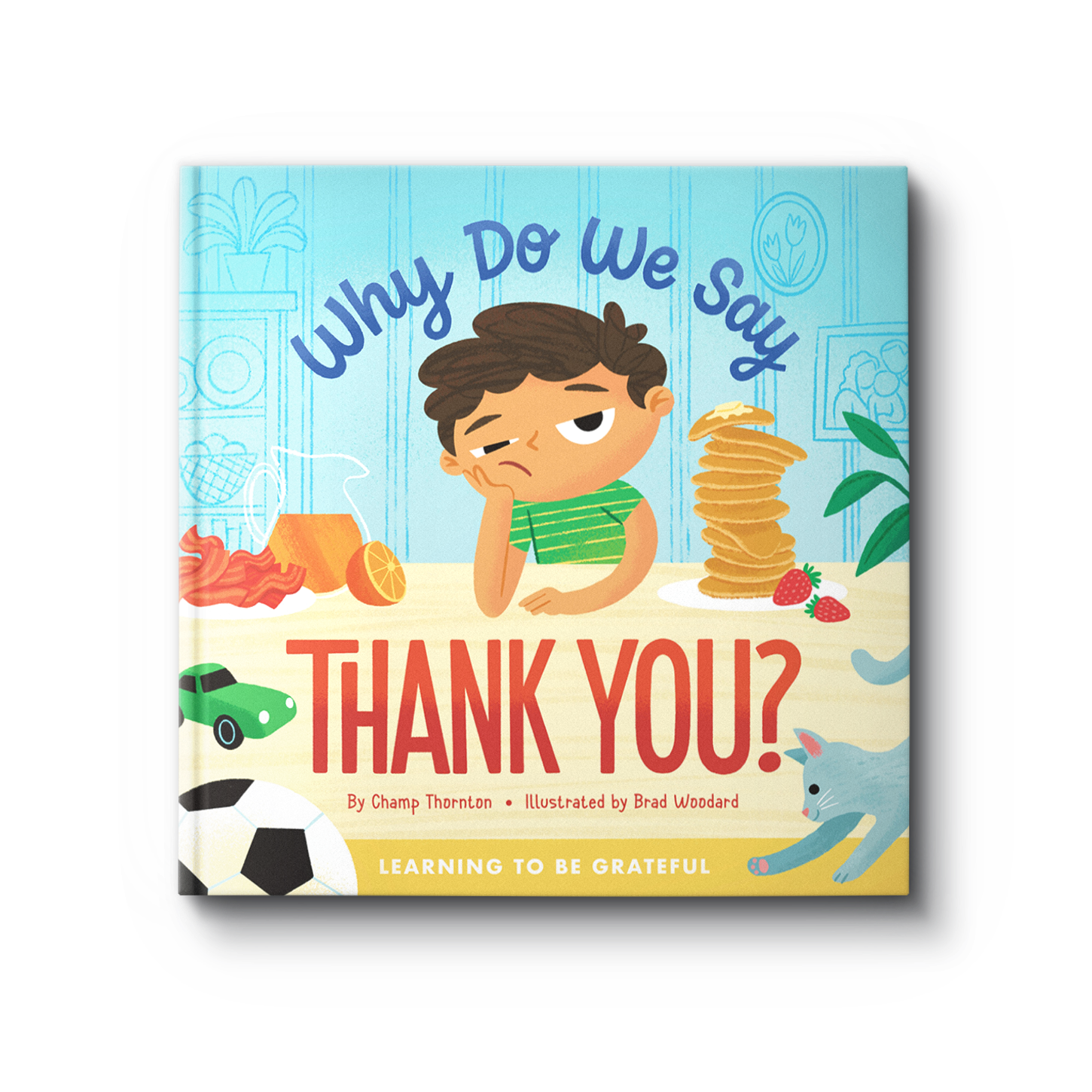 |
 An Interview with Champ Thornton, Author of Why Do We Say Thank You? Often, kids (and grownups too) don’t feel thankful. It’s easy to complain about things, even when there are so many wonderful blessings all around us. But in the Bible, God says “in everything give thanks.” The young boy in Why Do We Say Thank You?: Learning to be Grateful by award-winning author Champ Thornton learns that thankfulness is a choice—it’s about paying attention to God and the glory of the world he has made. Q: When the young boy in Why Do We Say Thank You? wakes up, he just can’t find anything nice to say about anything. Did he wake up on the wrong side of the bed? Please introduce us to the story.First, I have to say that the little boy in the story, I like to call him, “grumpy boy,” is not based on any person I know. Of course, we all find ourselves struggling with grumpiness from time to time. And that’s what this book is aimed to address. The question is not really what’s going on with the boy, but what’s going on with grumpiness in general.In summary, the story tries to show that grumpiness is often a matter of seeing—or rather, of not seeing. The grumpy boy doesn’t see—doesn’t see everything around him that’s good, doesn’t see the wonder of God’s creation, doesn’t see what’s really true and enjoyable. As you read the story, notice how often some reference is made to seeing. If he really saw the goodness of God’s creation, he would not be as grumpy (or as bored). Q: The boy’s biggest complaint is that everything “is as boring as boring can be.” How do boredom and ingratitude go hand in hand?Great question! Since grumpy boy does not see all the goodness of God’s creation that’s all around him, then he’s not captivated by the wonder of it all. When nothing is good or amazing, then it’s no wonder that everything is boring.As I mention in the comments to parents at the end of the book, sometimes not being thankful is expressed through feeling bored, then complaining. These attitudes may reflect that someone is having a bad day. But at heart, they may also signal that one is missing the connection between the Creator and his creation. Unbelievers shut their eyes to the Source of the world they live in (Romans 1:21). But God intends his people to enjoy what he’s made, to recognize why they enjoy it (because he made it), and to give him thanks. Q: What happens to change the boy’s attitude on the second morning?Why Do We Say Thank You? uses a fun and fantastical dream to help children visualize the connection between the goodness of the Creator and the goodness of his creation. In day-to-day life, outside the book, we don’t actually see beams of light illustrating this connection. But your child can use their senses to experience God’s creation, and see the connection between God and his world through faith (2 Corinthians 5:7). Q: We can prompt our children to say, “Thank you,” but that doesn’t really teach them to be thankful. How do we teach them where gratefulness comes from?Thankfulness is a matter of seeing—seeing the connection between the gift and the Giver. And this is what English poet and pastor George Herbert wrote in his prayer, titled The Elixir (1633). Here’s an excerpt:Teach me, my God and King, In all things Thee to see, And what I do in anything To do it as for Thee. . . .A man that looks on glass, On it may stay his eye; Or if he pleaseth, through it pass, And then the heav’n espy.In other words, you can look at everything like you would look at a window. You can look at it, or better yet: you can look through it. This is what we need to teach our children. We need to help them look at something God has made and then look through it—all the way to its Source. God made everything to point to him, to direct our eyes heavenward. So should train the eyes of our heart (and our children’s hearts) to see through all the gifts we enjoy, all the way to the Giver. And give him thanks.  Q: The back of Why Do We Say Thank You? includes a special section for parents which is a great resource on helping your child learn to be thankful. Would you tell us more about those pages?There’s so much biblical truth that connects to our saying “thank you.” The special section to parents is designed to connect those dots. In sum, those pages teach that cultivating a heart of gratitude requires eyes that see the connection that exists between the things we enjoy and the God who gave them. God created all things for us to enjoy (1 Timothy 4:4), and he wants us to acknowledge him and give him thanks (Romans 1:14).But here’s something I had originally hoped to include in the special section to parents: a quotation from C. S. Lewis and how it relates to our giving thanks.In an essay, “Meditations in a Tool Shed,” (originally published in The Coventry Evening Telegraph on July 17, 1945) Lewis, the author of The Chronicles of Narnia, described a beam of sunlight streaming through a crack in the wall of a dark tool shed. He observed that you can look at the beam of light itself or you can let your eyes trace the light to its source: “Then I moved, so that the beam fell on my eyes. Instantly the whole previous picture vanished. I saw no toolshed, and (above all) no beam. Instead I saw, framed in the irregular cranny at the top of the door, green leaves moving on the branches of a tree outside and beyond that, 90 odd million miles away, the sun. Looking along the beam, and looking at the beam are very different experiences.”If children (and adults) can grow to see the beauty and glory of God as it’s displayed in the world he has made, then they will learn to enjoy the gift, follow the “beam” back to its Source, and give thanks the Giver (Psalm 147:7–8; Matthew 8:6–8). Q: Can you share a couple of tips for helping your children learn to say thank you?One morning in early 2013, I wanted to capture in words my vision and heart for the next generation. So I sat down at my laptop and tried to articulate important lessons that the Lord had been teaching me as a father, pastor, and writer. The principles—written for our church’s children’s ministry—aimed to connect, to pull together, what oftentimes sin will separate. (After all, doesn’t sin drive a wedge between what God intended to unify? Sin divides God and people, divides people from each other, and divides the harmony between humans and the natural and spiritual worlds.)By the end of the day, one part of the new Kids Connection vision sounded something like this. “Each week we seek to bring together the following elements which sin tends to push apart. We are all about . . .Connecting God to Life—Every toy, snack, and game serves as a magnifying glass through which to behold God’s glory. Therefore, we want our children to see God’s hand in every area of life: snack time, strong muscles, warm air, cool water, fingers and toes, bright colors, weather, family members, etc. We must intentionally seek to connect God with all of life. (Psalm 145:4)This principle—connecting God to life—takes aim primarily at the heart of thankfulness. And this is a wonderful way to start teaching thankfulness to your children. Q: How do the illustrations by Brad Woodard support the message you are trying to teach in the book?I love what Brad Woodard at Brave the Woods has done in illustrating this little book! The pictures are so captivating—and that makes the grumpy boy’s lack of enjoyment so much more striking. And then there’s grumpy boy—Brad’s drawn him so vividly—you can feel his grumpiness coming through. And then there’s the fun and fantastical dream sequence. In these pages, Brad’s illustrations show streams of light that come down and hint at the reality that all good things come from God. They are like “light strings” that connect the creation with the Creator. And when the boy wakes up, the change is then seen in the boy’s eyes. Now he can see the goodness of God’s creation, and after asking the Lord and his parents to forgive him, he gives thanks for all the blessings God has given. Q: A wide variety of authors provided inspiration for Why Do We Say Thank You? Can you share more about the books you loved as a child and into adulthood that shaped your writing?As I mentioned above, some authors that influenced this story are C. S. Lewis (especially his essay, “Meditations in a Tool Shed”) and George Herbert (specifically his poem, The Elixir). As a child, the kind of books I enjoyed most were picture books, especially ones by Dr. Seuss. I would bring huge stacks of books to my mom and ask her to read one after another. Before I learned to read, she probably read thousands of books to me. It created in me a lifelong love of books and reading, and later to read books to my own three children. And because of all she did, I am dedicating this little book—which is set in the same kind of rhyme that Dr. Seuss usually used—to my mom. Q: Heading into the holiday season, tell us about some of your other books for families and children that would make great gifts.Why Do We Say Good Night? is a short, rhyming picture book for helping children who are struggling with fear at bedtime.The Radical Book for Kids is a book for middle-schoolers that gives 67 short chapters on a huge assortment of topics related to the Christian life. Like a smorgasbord, it covers parts of the Bible, spiritual disciplines, biblical theology, dealing with life problems (fear, anger, etc.), practical concerns (how to make good decisions, how to clean your room, etc.), biographies of men and women in church history, and a lot of fun all along the way.Wonders of His Love: Finding Jesus in Isaiah is an Advent devotional for families. Perfect for busy families with younger children, each week of Advent focuses on one of Isaiah’s images and has readings related to the week’s theme—Jesus the Light; Jesus the Branch; Jesus the Shepherd; Jesus the Savior—and, on Christmas Day, Jesus the Bread. Each week also includes fun stories, discussion questions, crafts, recipes, games, and suggestions for family service projects. Why Do We Say Thank You?: Learning to be Grateful By Champ Thornton, Illustrated by Brad Woodard October 17, 2022 / Retail Price: $16.99 Print ISBN 978-1-64507-214-0 Religion / Christian Education / Children & Youth  About the Author and Illustrator  |
-
Sexual Content - 0/5
0/5
-
Violence - 0/5
0/5
-
Language - 0/5
0/5
-
Drugs and Alcohol - 0/5
0/5

